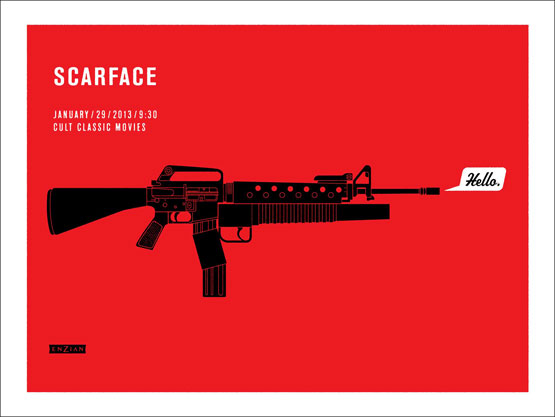“The World is Yours, Chico” Scarface, Racial Identity, and the American Dream
[youtube https://www.youtube.com/watch?v=7pQQHnqBa2E&w=560&h=315]
Scarface was released in 1983 as a reimagining of a 1930s gangster film of the same name. Directed by Brian De Palma and written by Oliver Stone, Scarface transposes the crime drama onto a contemporary setting in Miami, with over-the-top violence and a B-movie aesthetic sensibility. Despite its mixed critical reception at the time, the movie has loomed large in the popular imagination. One potential explanation for this is the way in which Scarface resolves racial/ethnic tension, as well as the burgeoning drug wars in the United States through a capitalist framework. Although Scarface follows the plot and formula of the Hollywood gangster genre, it stands out as one of the first to feature a non-white immigrant protagonist.
After describing his desire for economic agency to the immigration officials at the beginning of the film, Tony Montana is depicted working his way up from poverty through criminal capitalism and entrepreneurship. This movie both critiques, at some level, the economic system that rewards only a select few (Montana has various lines that directly address the uphill battle he faces) and embraces it–albeit through brutal violence and drug smuggling. Thus, Montana has become a romanticized masculine emblem for “outsider” populations that identify with the fatality of struggling for success through conventional routes.
The issue of race first emerges with the casting of Al Pacino, an Italian American, as a Cuban immigrant. Pacino’s performance has been read by some critics as a mockery because of the ridiculous accent and slang he uses, and the brown-face makeup he wears. Outside of the issues of casting a white actor to play a Cuban one, the film directly addresses the nationality and immigrant status of the protagonist. The outsider status of Tony as a poor immigrant, or non-white man continues to resonate across racial lines, and Scarface is celebrated for its narrative that seems to undermine the white capitalist system, creating oppressive class boundaries.
The imagery of Scarface and its re-imagination of the rags-to-riches ideal as a battle of life and death (with little hope for positive outcome) has been widely referenced and appropriated in hip-hop culture. The continuous recycling of what could have been just another 80s gangster film underscores the its importance in American consciousness. In his study of viewers of Scarface, Rob Prince found that viewers’ reactions to the film were more dependent on their class than race. Prince writes, “criminal behavior is very likely to be accepted by an audience if that audience itself needs money to solve its real life problems,” implying that the approval of Tony’s behavior is based on the dissatisfaction viewers felt with their own economic situation. He later summarizes how Scarface was able to be understood as a rebellion against oppressive hierarchies. Scarface “offered them a hero who represented, as Public Enemy would implore years later with the anthem “Fight the Power,” the militant opposition to the white male hegemony which oppresses them.”
Since the release of Scarface, the American Gangster has been popularly conceived and represented in movies, hip-hop music, and news as a young Black man trying to “make it” in a harsh environment. Inevitably, both the old and new conceptualization of the gangster involves the rise and fall of the criminal protagonist, as he forcibly takes the money and power that are integral to the American dream. In this temporary redistribution of wealth that the gangster story narrativizes, the appeal remains for those who feel disenfranchised without disrupting the fundamental belief in the justice of the capitalist system.
Scarface Remembered in Contemporary Popular Culture
The continuing power of this narrative is evident in the vast amounts of products and material culture that remains in production. At malls, it is virtually impossible NOT to find a Scarface t-shirt, poster, or pendant. Many artists reimagine the branding, quotes, characters and imagery associated with Scarface and sell their wares online.
Additionally, hip hop and rap artists have fully embraced the rhetoric of Scarface in their songs and names. A documentary, entitled, “Scarface: Origins of a Hip Hop Classic,” was made in 2003 and featured various celebrities like Snoop Dogg and JayZ describing their attachment to the movie. Comments throughout this movie indicate the romantic fantasy that emerges, and the way it speaks to young black and latino men.
The president of Def Jam records astutely observes: “I think people don’t realize the importance of a flick like this. You got something that failed in the box office, but became a ghetto classic.” Indeed, the distribution, critical reactions, and urban consumption of the film seem to parallel the narrative within the movie. Describing it as a “cult classic” seems to discredit the overwhelming mainstream attachment to the film in the American popular imagination. As of today, Scarface has an 84% positive rating on the aggregator site, RottenTomatoes, and 8.3 on IMDB. American Film Institute has also ranked Scarface as the 10th greatest Gangster genre film, and is on the top 100 list for the quote “say hello to my little friend,” which has been endlessly ridiculed, recycled, and reinvented in a plethora of tv shows and movies.
[youtube https://www.youtube.com/watch?v=Nibk75kDzEg&w=420&h=315]
Additionally, we can see the reiteration of the theme in “Tony Montana” by Future (featuring Drake), released in 2011 with over 9 million views. The song repeats the name of the protagonist over and over, and cites scenes, symbols, and dialogue within the lyrics. For a list of other rap songs referencing Scarface, see this list by IFC.
[youtube https://www.youtube.com/watch?v=CNdySYdVe0E&w=560&h=315]
Even Disney movie, Tangled, references Tony Montana’s pivotal scene in the elite restaurant where he calls out the white, wealthy people around him, as well as the audience watching.
[youtube https://www.youtube.com/watch?v=dW37AGZ0Pj0&w=560&h=315]





